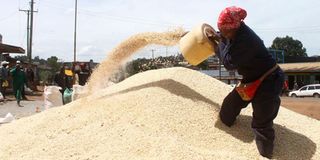Premium
Farmers earn peanuts as buyers pay more for food

Farmers dry maize in Elburgon town, Nakuru County, on January 22, 2022. Kenyan farmers have earned less even as consumers pay more for food products, a new report has said.
Kenyan farmers have consistently earned less even as consumers pay more for food products, a new report has said.
A report by the Food and Agriculture Organisation dubbed the World Bank and Agriculture Statistical Year Book 2023, compares annual changes in earnings received by farmers against inflation in food consumer prices.
It shows a persistent disparity between an increase in consumer food prices and the take-home received by farmers through to the end of 2022.
For instance, inflation in food consumer prices stood at 12.9 per cent against a lesser increase in prices received by farmers at 7.1 per cent. In 2021, inflation in food consumer prices was recorded at 8.9 per cent against a 3.8 per cent increase in money received by farmers over the same period.
The disparity was at its widest in 2020 when the annual change in earnings received by farmers contracted by 44.1 per cent against a 6.4 per cent growth in food consumer prices inflation.
Prices fetched by Kenyan farmers are usually influenced partly by an inefficient market structure that features a hoard of intermediaries between producers and the end consumer, driving down value for farmers.
According to an investigation by the Nation published in November last year, middlemen dictate what a farmer gets with the actors including corrupt police and county officers manning roadblocks contributing to the divergent wholesale and retail prices.
Investigations revealed the manipulation of pricing right from the farm gate to the retail outlet with the middlemen allocating profit margins in the value chain, largely to their advantage.
The FAO report traces the spike in food consumer prices, mainly to periodic shocks to global demand and supply chains.
“The FAO food price index declined during the early phase of the Covid-19 pandemic reflecting uncertainties faced by commodity markets," the report noted.
"However, it surged between May 2020 and March 2022 to its highest value ever, due to a combination of factors including the effects of the Covid-19 pandemic on the supply chains, the rebound in activity and demand experienced in 2021, and the disruption to exports of cereals and vegetable oils from the Russian Federation and Ukraine."
Meanwhile, the report attributes disparities in prices received by farmers or producer prices to a combination of factors with the largest fluctuations often taking place in Asia and Africa.
“Many factors can affect producer prices, including favourable or poor harvests compared to the previous year, production costs, market structure, subsidy schemes and external factors,” the report added.

